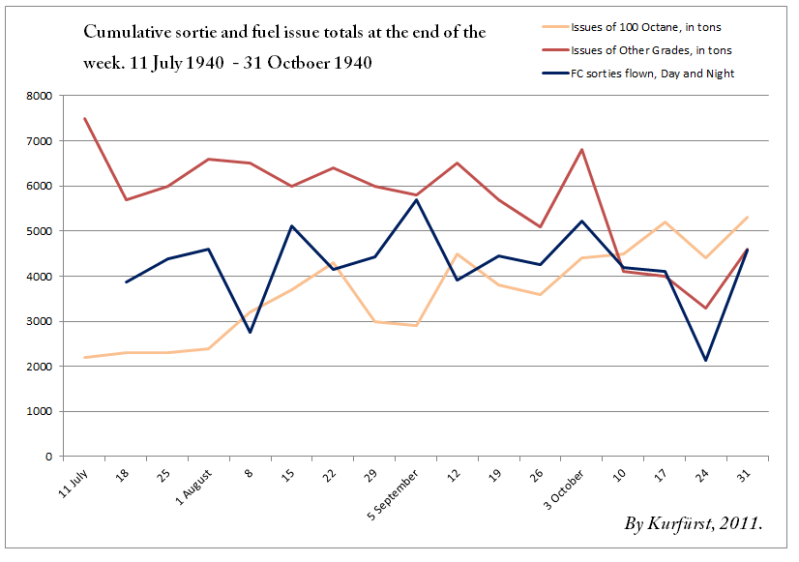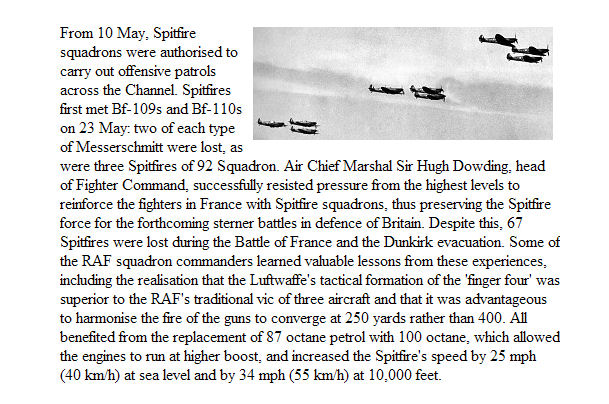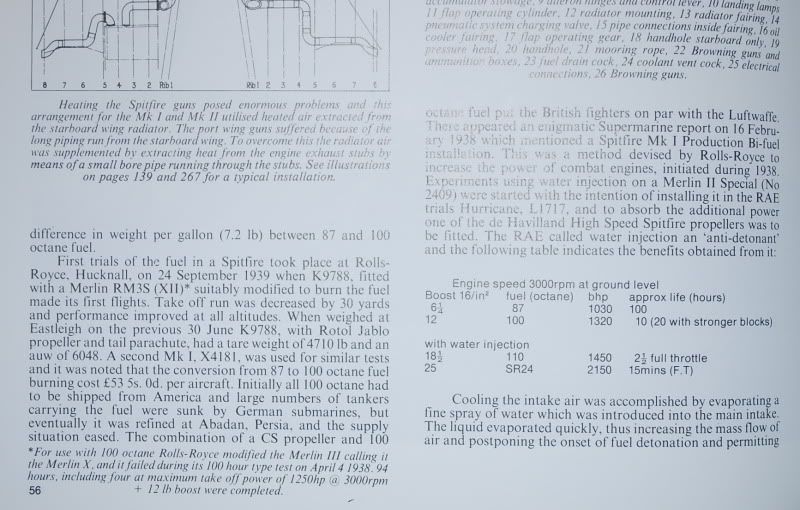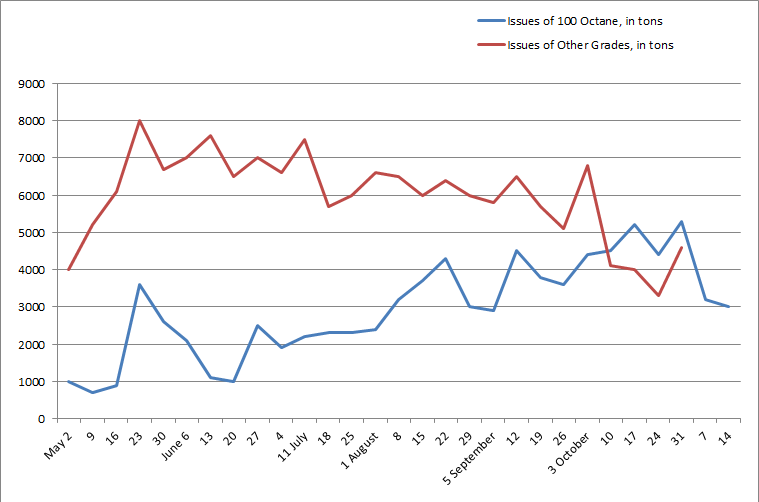
 |
|
|||||||
| FM/DM threads Everything about FM/DM in CoD |
 |
|
|
Thread Tools | Display Modes |
|
|
|
#1
|
||||
|
||||
|
Glider, why aren't you posting proof that all RAF units were supplied with 100 octane?
|
|
#2
|
|||
|
|||
|
Quote:
Posting 2 Shows the instruction from the Chief of the Air Staff for fighters and Blenheim units to be equipped with 100 octane. The ACAS has made the request but its safe to assume he wouldn't do this without the authority from the top. Its a clear request without any limits, it doesn't say certain, or limit the issue by Group or any other qualification. Posting 3 Contains two papers the one that Kurfurst quotes saying Certain squadrons and the second paper that gives the actual status in both Bomber and Fighter commands. Its worth noting that I didn't have to post the first paper, I knew at the time that the word 'certain' could be used to discredit the position and had I not posted it no one would have known, but for completeness I did include it. If you look at my posting 12 it includes the line I could see one line which I knew Kurfurst would almost certainly leap on and could have left it out, but that would have broken the train so I kept it in. I can only assume that he didn't dare use that word then but has now decided to do so. Anyway back to your question. Posting 4 Here you can see that as a cost saving measure the Authorities wanted to keep one tank of 87 octane for visiting aircraft passing through. Bomber Command were against this and permission was given in some cases for all the fuel to be 100 Octane. Note the terminology - the 87 Octane wasn't for non operational flights, but for aircraft passing through. Note also the reference to the four bomber bases - these four bases were the only ones allowed to be 100% 100 Octane, the other bases had to keep one tank for the aircraft passing through. It certainly wasn't only these four bases were to have 100 octane. Posting 5 is an update report Posting 6 Is the paper confirming the completion of the switch from 87 to 100 octane. I do make the observation that What is interesting is what isn't in the file and its a big file. At no stage is any concern expressed about any shortage of 100 Octane Fuel the level of stocks or any lack of supply. There was never any mention of capping distribution or shipping stocks from one station to another or sector Posting 12 This is interesting for a different reason. It refers to the experimental production of 100 Octane fuel at a UK Refinery which produced 35,000 tons over four months, at a time when average useage was 10,000 tons a month. In other words had there been a shortage then the UK could easily have been self sufficient. The experiment did take place but due to cost grounds it was switched back to normal production when complete I was asked if I had a list of when each station was equipped with 100 octane but there wasn't a schedule in the NA files. It should also be noted that Kurfursts position was that only 18 fighter squadrons were equipped with 100 Octane which is one reason why I was asking him to state what number of aircraft or squadrons was he talking about in this forum being equipped with the better fuel. It should be noted that we identified well over 30 squadrons which reported the use of the extra boost and additional stations which had 100 octane over and above the ones listed in the records. 100 octane was used in France and Norway so it was widely used and a standard issue Posting 63 Kurfurst was getting a little desperate at this stage and I was totally open about my position saying I think one thing has to be made clear. Can I give a 100% Cast Iron, Gold Plated guarantee that every station in fighter command had 100 Octane fuel. No I cannot, as that would involve checking vast amounts of data and I have a life to lead, so in short there could be one station in the back end of nowhere which didn't get the fuel. As Kurfurst rightly pointed out I used the phrase , "sources links that exist and support the view that Fighter Command was effectively fully converted to 100 Octane by May 1940. Note the word effectively. That said I do believe and there is no evidence in my mind to contridict the view that all stations did have the 100 Octane Fuel. This remains my position. There is no evidence anywhere that Fighter Command was anything but 100% fully equipped with 100 Octane. Hundreds of books have been written about the battle, probably more than on any other conflict and scores or personal memories and no one ever has mentioned this theory. No one has mentioned the obvious logistical or practical problems that having mixed fuel would mean. We have a document trail from the instruction from the Chief of the Air Staff asking for fighters to be equipped with 100 Octane and the other papers that follow the implementation until completion. Why did someone type in certain on one paper I have no idea and am not making any assumptions. We have other papers that were issued by Dowling about the dangers of using the extra boost and not telling the ground crews, papers that were issued to all of fighter command not just some units or stations. Against this we have a paper that is supposed to exist in Australia which they have never heard of, which Kurfurst has never seen and had never asked for and finally if it does exist, is riddled with errors. I am very aware that I have made serious accusations about Kurfurst but I have supported my comments and before anyone deletes these postings I suggest you check them out. If you incorporate his theories into any code then you do stand a chance of being made to look very foolish.. Last edited by Glider; 06-17-2011 at 08:56 AM. |
|
#3
|
||||
|
||||
|
Quote:
Stop editorializing what you think Kurfurst is doing (Kurfurst is desperate, etc) it only serves to make you look petty, petulant, and juvenile. Indeed from reading your postings at ww2aircraft.net that is the conclusion to which I have come about your character. In any case, I'm still reading the two threads and have yet to come across any definitive proof that RAF aircraft were 100% equipped with 100 octane at all times. I'm willing to be persuaded but that has not yet occurred. |
|
#4
|
||||
|
||||
|
Kurfurst,
Could you kindly post a link to this article written by the australian author directly? I have been waiting almost 2 weeks for my account at allaboutwarfare.com to be activated but it hasn't happened yet. |
|
#5
|
|||
|
|||
|
Data of the Fiat G.50 Freccia.
Weight(MTOW): 2402 kg Empty weight: 1963 kg Max speed: 472 kph/5000m Cruise speed: 415 kph Range: 670km Ceiling: 10,700m Climb rate: 6000m in 7'30'' ,5000m in 6'3'' Weapons: 2x Breda SAFAT with 150 rounds p/gun Gunsight Type S.Giorgio at riflesione Ammo: Counter included in panel Fire system: Warning light, extintor at biossido di carbonio. Radio: ARC 1 Fuel: 260 l(provision for 52 l of aux fuel in a fuselage tank) Power: Engine Fiat A.74 RC, radial, 14 cylinders 740 HP in take off. 840 HP with 2400rpm at 4000m 879 HP with "+100"(WEP) Propeller: Hamilton Standard 3D-41-1, constant speed, passo variabile Misc: In panel/cockpit: Carburator heat switch, gear indicators, fire warning light, compressed air indicators, ammo counter, engine instruments, compass, cowling flaps selector, Flaps lever, parking brake lever. Other: The G.50 turn well to the right but less satisfactory to the left . Stall with 125 to 130 kph. Exit of stall with turn to the right. Dates from: "Fiat G.50 Le Macchine e la Storia, Stem Mucchi, Modena-Italia" Last edited by Danelov; 06-17-2011 at 07:17 AM. |
|
#6
|
|||
|
|||
|
Quote:
Quote:
The most interesting part is that "Pips" found this well before, in 2004 or earlier, and it agrees with every single document Neil managed to dig up afterwards, though Neil and now Glider tries to discredit this research with whatever means, basically calling Pips a liar behind his back at every opportunity, but never to his face.. The problem is, if Pip would have made it up, he was extremely talented, because Pips information from 2004 - for example that the large scale fighter conversion begun in late September 1940 - agrees perfectly with what Neil found in British archives in 2009 about 87 vs 100 octane consumption rates (and then waited two years before publishing it, as it was obviously not very helpful to his own thesis). Note that as per the consumption figures, 100 octane did not become the main fuel until late September 1940, just like Pips stated, 7 years ago. 
__________________
Il-2Bugtracker: Feature #200: Missing 100 octane subtypes of Bf 109E and Bf 110C http://www.il2bugtracker.com/issues/200 Il-2Bugtracker: Bug #415: Spitfire Mk I, Ia, and Mk II: Stability and Control http://www.il2bugtracker.com/issues/415 Kurfürst - Your resource site on Bf 109 performance! http://kurfurst.org 
Last edited by Kurfürst; 06-17-2011 at 03:14 PM. |
|
#7
|
||||||||
|
||||||||
|
Quote:
Quote:
Quote:
The question I suggest we need to ask is If you have what is in effect a two and a half year stockpile, is this a strain, let alone a great strain on the stockpile. In my opinion it isn’t a strain at all, it’s barely noticeable Quote:
Quote:
Quote:
Quote:
Quote:
I should point out that all my comments are supported by original documentation. The posting isn't supported by anything. If the people working on the code base there scenario's on Pips posting as above, they have only themselves to blame if the adverse comments arrive. Last edited by Glider; 06-24-2011 at 09:39 PM. |
|
#8
|
|||
|
|||
|
Quote:

|
|
#9
|
||||||||
|
||||||||
|
Quote:
Quote:
At 10 000 tons per month consumption the storage would be enough for 20 months, but this is with about 25% of the fighters and some bombers running 100 octane. Complete conversion would have meant the reserves would not be enough for more than about 5-6 months, running out by October. Morgan and Shacklady in Spitfire the History also notes the concerns about supply, and the U boot thread. In fact up to that time about 300 000 tons of oil shipments were sunk by uboots and mines.  Quote:
Quote:
So in three months the equivalent of one months of supply arrived. Do we need to make even more clear why the British were concerned about a complete conversion to 100 octane? Quote:
 Noteworthy that the consumption remains pretty much the same between May (when select Fighter Squadrons converted) and late September 1940. Quote:
Quote:
Quote:
__________________
Il-2Bugtracker: Feature #200: Missing 100 octane subtypes of Bf 109E and Bf 110C http://www.il2bugtracker.com/issues/200 Il-2Bugtracker: Bug #415: Spitfire Mk I, Ia, and Mk II: Stability and Control http://www.il2bugtracker.com/issues/415 Kurfürst - Your resource site on Bf 109 performance! http://kurfurst.org 
|
|
#10
|
|||
|
|||
|
Quote:
Being serious for a moment, if you have any questions or explanations don't hesitate to ask either on the forum or by PM. That offer is obviously open to anyone. |
 |
| Thread Tools | |
| Display Modes | |
|
|